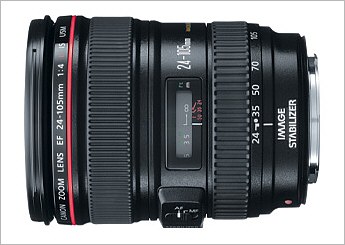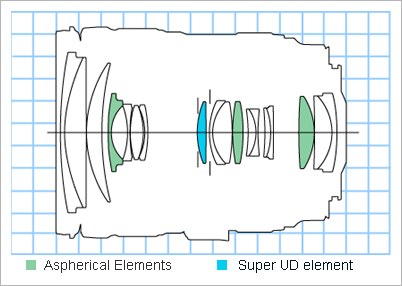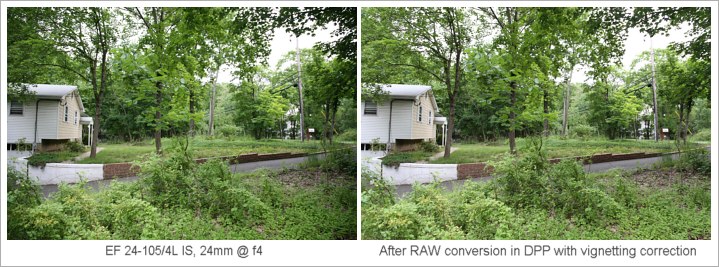

Canon EF 24-105/4L IS USM Lens Review

Over the last few years Canon have been developing a lineup of "L" series f4 lenses alongside their more traditional f2.8 offerings. The f4 lenses are smaller, cheaper and lighter than the f2.8 series, but still have "L" series quality and features such as weatherproofing and solid construction.
The f2.8 series include the 16-35/2.8L, the 24-70/2.8L and the 70-200/2.8L (IS), while the f4 series consists of the 17-40/4L, the 24-105/4L IS and the 70-200/4L (IS). The lens reviewed here is the EF 24-105/4L IS USM. This lens has a very useful range of focal lengths, probably more useful then the EF 24-70/2.8L. At 24mm the lens is a true wideangle. 24mm is one of my favorite wideangle focal lengths (in fact before I bought the 24-105/4L, the 24/2.8 prime was probably my most used wideangle). Both lenses cover the "normal" range around 50mm, but the 24-105/4L IS goes on to cover the "portrait" range which many consider to be 80-100mm. On a full frame camera focal lengths of 80 to 100mm give very pleasing perspective for "head and shoulders" type portraits. The 70mm limitation of the 24-70/2.8L means it's less useful for portrait work (though the extra stop of speed is nice). The 24-105/4 at 23.6 oz (670g) is significantly lighter than the 28-70/2.8 [33.6 oz (950g)].
Another advantage of the 24-105/4L IS is that it has built in image stabilization, good for about an extra 3 stops of stability. So if you can shoot at 105mm at 1/125s and get sharp images without IS, you should be able to shoot at around 1/15s at 105mm with IS on.
When the 24-105/4L IS was first introduced (alongside the 70-300IS) in 2005, the initial samples suffered from flare under some conditions, but the design was soon fixed and lenses made from 2006 on have no problems.

The 24-105/4L uses one Super UD glass element and three aspheric elements (see diagram above) in order to maximize image quality and minimize aberrations, even when the lens is used wide open at f4.
The EF 24-105/4L IS USM is supplied with a lens hood and a soft carrying case. It's just as well the hood comes with the lens as Canon charge an exorbitant $60 if you buy it separately - so don't lose it! It's a fully weather sealed lens, meaning it has gaskets behind the switches, focusing and zoom rings as well as at the lens mount. The lens mount seal is only fully effective when the lens is used on body with weather seals, which are basically the EOS 1 series bodies. Canon recommend the use of a UV filter (77mm) for extra protection if the lens is used in the rain.
Handling
The 24-105/4L IS balances nicely on a 40D or 5D. It's not a lightweight lens, but it's pretty compact and easy to hold. One thing that confused me a bit is that the zoom ring is at the back of the lens and the focusing ring is at the front. On most consumer zooms with USM motors (e.g. 20-35, 28-135IS, 17-85IS), the zoom ring is at the front and the focusing ring is at the back. You soon get used to it, but I did find myself focusing when I really wanted to zoom a few times!
The construction of the lens is very solid, though it does make more use of more plastics than the longer all metal barrel "L" series telephoto zooms. Zooming and focusing action is smooth and well damped as you'd expect from an "L" series lens. It's black of course, which makes it a little more "stealthy" than the white lenses like the 70-200/4L.
The hood (which is supplied with the lens but costs $60 to replace if you lose it!) is quite shallow, but since the lens zooms to a wide 24mm setting, it has to be. It's "petal" shaped to give the maximum possible coverage, but it's still not going to be very efficient when the lens is zoomed out to 105mm. This is a problem with all zooms of course. One advantage of the shallow hood is that it's possible to reach in and rotate a polarizer attached to the lens. The hood is designed for use on a full frame camera. It works just fine on an APS-C DSLR too, it's just not as efficient as it could be even at the 24mm setting, since the smaller angle of view would allow the use of a deeper hood without it causing vignetting.
The 77mm filter size means it can share filters with several other lenses such as the EF 300/4L, EF 400/5.6L, EF 20-35/3.5-4.5, EF 17-40/4L, EF 16-35/2.8L, EF 24-70/2.8L, EF-S 10-22 and a few others. Note that the latest EF 16-35/2.8L II takes an 82mm filter though (I think it's the only Canon lens that requires a front filter larger than 77mm since the large telephotos use 52mm drop in rear filters). 77mm filters can also be used on all smaller filter size lenses of course via step-down adapters, though in that case you normally can't mount the lens hood at the same time.
The wide focal length range (from widangle to short tele) is best used on a full frame camera. On an APS-C body if becomes more of a "normal" to tele zoom since 24mm on APS-C gives you the same field of view as a 35mm lens on full frame. However the 24-105/4L IS couples very well with an EF-S 10-22/3.5-4.5 lens on an APS-C DSLR like the 40D. If you have both lenses, nobody will miss not having 23mm and you'll have the equivalent of lenses from 16mm to 168mm in full frame field of view terms (except you won't have 37mm!)
Performance
Most of what I say here will relate to the full frame performance of the lens (on an EOS 5D). It can of course be used on any Canon SLR or DSLR including the EOS 20D/30D/40D and Digital Rebel series cameras. Since the APS-C sensor cameras essentially crop the full frame image, the performance at the sensor on such cameras with regard to things like vignetting, distortion, chromatic aberration and edge sharpness will be even better than the performance on a full frame camera. This is because the APS-C sensor just samples a "sweet spot" from the center of the frame where most aberrations are lower than at the edges. The penalty is, of course that you lose some angle of view and you have to enlarge the cropped image more (1.6x more) to get to a given print size - which lowers the overall quality (just like printing from small vs. large film negatives).
Distortion
Distortion ranges from moderate barrel distortion at 24mm to very low distortion in the 50mm range and mild pincushion distortion at 105mm. The distortion probably wouldn't be very noticeable in most normal images, but if you're doing architectural work with lots of vertical and horizontal lines near the edges of the image it could be a matter of concern. The distortion can be corrected digitally of course and Canon's own DPP RAW converter can automatically apply corrections to RAW images taken with the 24-105/4L IS. If you are shooting slides or negatives for conventional optical printing (which is pretty unlikely these days, but possible), you'd probably want to pick a prime lens for minimum distortion. For everyone else, zoom distortion is a fact of life and can be corrected with little or no noticeable effect on image quality.
Vignetting
As you'd expect, when used wide open there is some vignetting (corner darkening) on full frame images. At 24mm with the lens wide open you'll notice dark corners, especially if they are a uniform tone (e.g, a blue sky). At 50mm and 105mm the vignetting isn't at strong as it is at 24mm, but it there. Again if you're shooting a scene with uniform corners, you'll notice it. Stopping down a stop to f5.6 significantly reduces the strength of the vignetting. Since the APS-C frame crops the center out of the full frame image, vignetting on an APS-C DSLR like the 40D is not noticeable, even with the lens wide open at 24mm. In fact some APS-C owners who have been using full frame lenses and upgrade to a full frame DLSR might get a surprise when they see that a most (if not all) their lenses now show vignetting!Below is an example shot with an EOS 5D and the 24-105/4L set to 24mm and f4. The shot on the left is a JPEG straight from the camera. The effect of the DPP automatic corrections during RAW conversion is shown on the right.

You can see that the corners have brightened up. The lens correction function in DPP can also simultaneously correct for distortion and chromatic aberration. One more note about corner vignetting. If you're making a large print, all the standard paper sizes crop the corners out since none have a 2:3 aspect ratio. So if you're making an 8x10, 11x14, 16x20, 20x24 or 24x30 print and you're printing the middle of the image, any vignetted corners will be cropped off anyway!
Image Stabilization
Canon claim a 3 stop stability increase with IS turned on and this seems to be accurate. At 24mm shots taken at 1/6s were pretty sharp and even about 50% of the shots taken at 1/3s were good. At 105mm most of the shots at 1/13s were good. Not quite as good as shots taken from a tripod of course, but acceptably sharp for most purposes. These numbers are consistent with Canon's claim of three stops of added stability. If you're shooting down at the 3 stop stability level (1/3s at 24mm, 1/13s at 105mm) it always makes good sense to fire of at least two or three shots to increase your chances of getting at least one sharp image. It's all a matter of percentages. The more shots you take, the better your chances that one will be sharp.
Sharpness
The 24-105/4L is sharp at all apertures in both the center of the frame and at the corners, even using and EOS 5D with a full frame sensor. There's only a slight increase in sharpness when stopped down to f5.6, which is more of an indication of how good it is at f4 then any problems at f5.6. It's maybe a touch less sharp at 105mm than at 24mm, but we're talking about a sharp lens at both focal lengths. The fact that it's very sharp wide open is impressive. Since this is an f4 lens rather than an f2.8, not having to stop it down to get sharp images is a definite plus.I compared the sharpness of the EF 24-105/4L IS at 24mm and f4 with a Canon EF 24/2.8 prime lens also at f4. Surprisingly the 24-105 zoom was sharper in the corners - though it did show more vignetting and higher levels of distortion. Center sharpness was similar and at f5.6 and f8 the two lenses were very similar, even in the corners.
On an APS-C sensor camera the performance looks even better since the corners of the full frame are cropped out and the sensor only sees the central part of the image, where aberrations are lower.
Chromatic Aberration
Chromatic aberration was well controlled at all focal lengths. Very slight color fringing was seen at the edges of the full frame image, but the auto corrections in DPP can correct that if you shoot in RAW mode, or you can eliminate it in image editors like Photoshop. The level of CA at 24mm was comparable to that of the 24/2.8 prime, perhaps a little less.
Flare
Flare was well controlled. The 24-105/4L has a rectangular diaphragm at the the rear of the lens, which no doubt contributes to the low levels of flare. When the lens was first introduced in 2005 there was a slight flare problem with some of the first batch of lenses when used wide open at 24mm, but that was taken care of quickly and lenses made from 2006 on do not have the problem. Canon have a page on this issue here. Note the date on that page is November 2005, so there's no need to worry about new lenses.
Conclusions
The is a very nice lens indeed. On a full frame DSLR it has an ideal focal length range for a single general purpose lens, with applications ranging from landscapes to portraits. It can be used wide open at f4 and still yield very sharp images and with the 3 stops of stabilization which the IS system provides, it's useful for low light work as well. It can yield sharp images at 1/3s at 24mm and 1/12s at 105mm. What's somewhat less impressive is the noticeable vignetting and distortion, especially at 24mm. This can easily be corrected digitally of course, but it's always better not to have it there in the first place. If the lens had been designed to eliminate vignetting and distortion though, it would probably have ended up much larger, heavier and more expensive and some of the zoom range might have had to be lost. If that's the case, the compromise is worth it.
On an APS-C DSLR the focal length range is a bit less useful, being similar to a 38 to 168mm on a full frame camera, so you don't really have wideangle coverage. However image quality is very high since the edges and corners of the image are cropped out, and that's where aberrations are strongest. If instead of a single lens you're prepared to carry two, then the EF 24-105/4L IS paired with the makes an excellent lens set, providing high quality coverage from 10-105mm (16-168mm full frame equivalent) with just two lenses.
The EF is sometimes available with full frame DSLRs as part of a "kit". The advantage of buying the kit is that the price in the kit is often lens than the price of the lens if you buy it alone.
EF 24-105/4L IS USM Specifications
| Focal length | 24 - 105 mm (on APS-C, 38.4 - 168mm equiv.) |
| Maximum aperture | f4.0 |
| Minimum aperture | f22 |
| Angle of view (full frame) | Horizontal: 74° - 19° 20' Vertical: 53° - 13° Diagonal: 84° - 23° 20' |
| Lens construction | 18 elements in 13 groups (One super UD and three aspherical elements) |
| Diaphragm blades | 8 (circular aperture) |
| Close focusing distance | 45 cm (17.7 in) |
| Max. magnification | 0.23x (at 105 mm) |
| Distance information (E-TTL II) | Yes |
| Weather Sealed | Yes |
| Front Element Rotation | No |
| Image stabilizer | ~3 stops |
| AF motor | Ring USM (with full-time manual focus) |
| Filter diameter | 77 mm |
| Dimensions (dia x len) | 83.5 x 107 mm |
| Weight | 670 g (1.5 lb) |
| Magnification with extension tubes | EF 12 II: 0.40 - 0.12 EF 25 II: 0.61 - 0.27 (only at tele) |
| Soft case (supplied) | LP1219 |
| Lens hood (supplied) | EW-83H |
| Compatibility with Extenders | EF 1.4x II: Not compatible EF 2.0x II: Not compatible |
